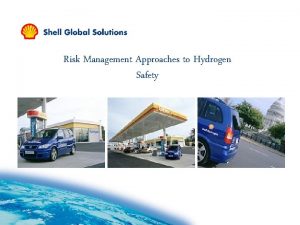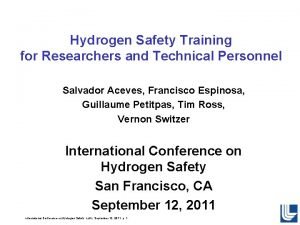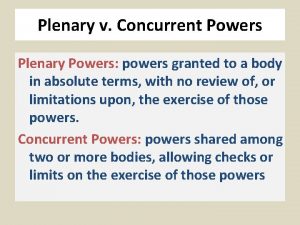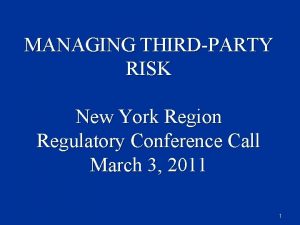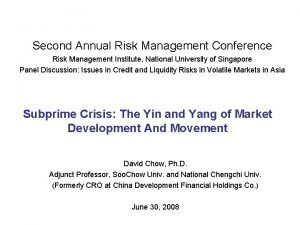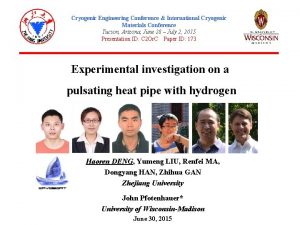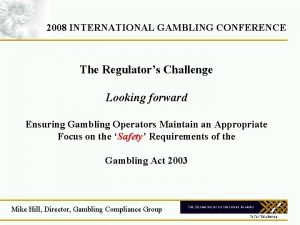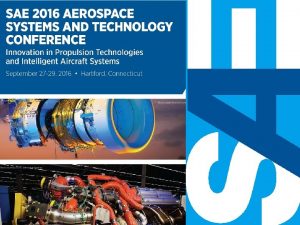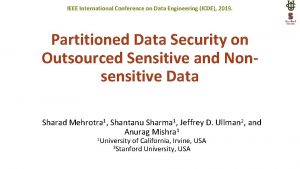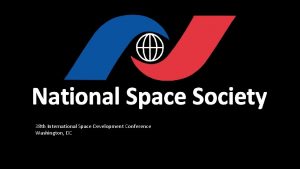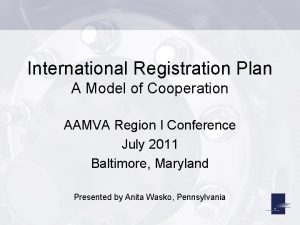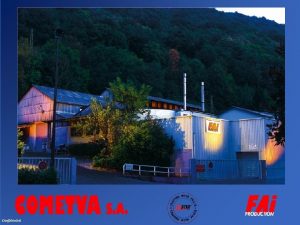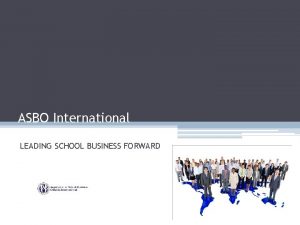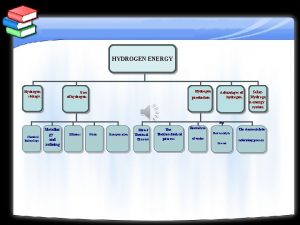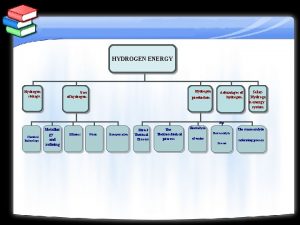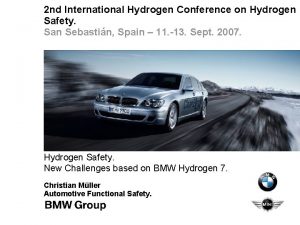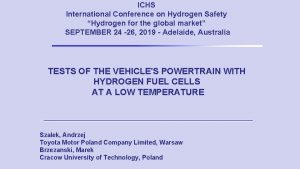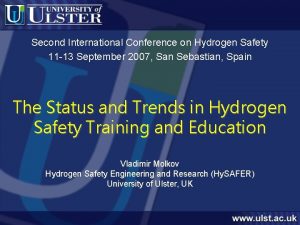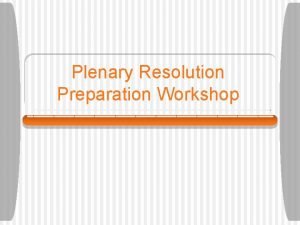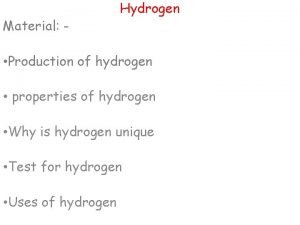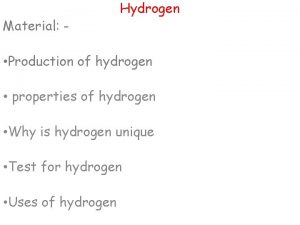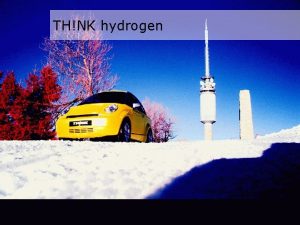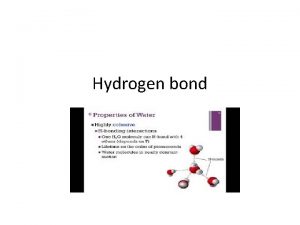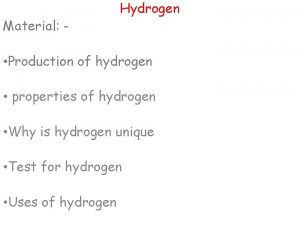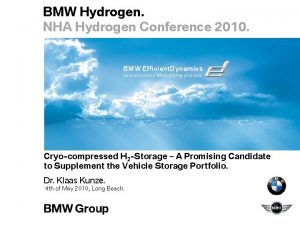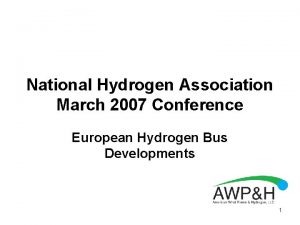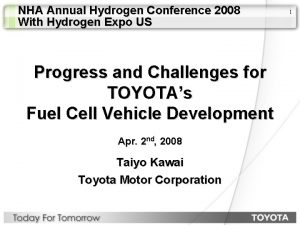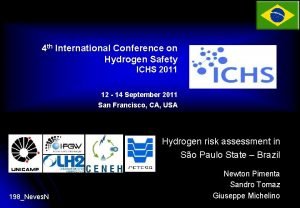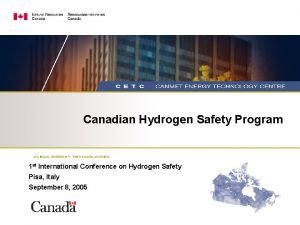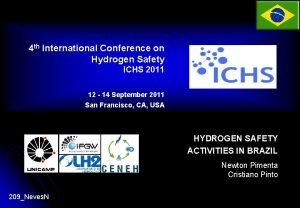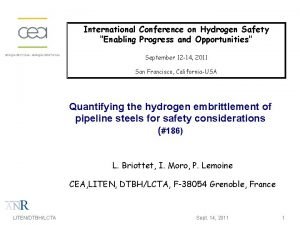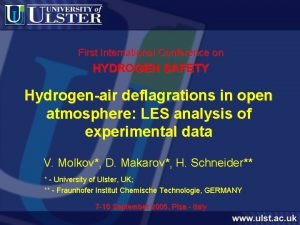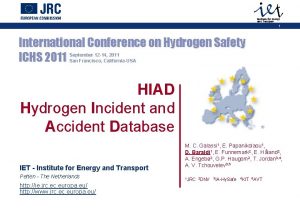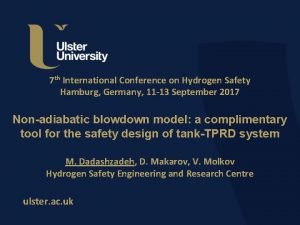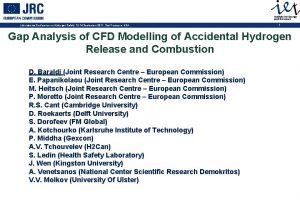INTERNATIONAL CONFERENCE ON HYDROGEN SAFETY Second Plenary Risk



































- Slides: 35

INTERNATIONAL CONFERENCE ON HYDROGEN SAFETY Second Plenary Risk Management Approaches to Hydrogen Safety, Regulations, Codes, and Standards (RCS) Risk Management Approaches to the Japanese Regulations of Hydrogen Supply Stations September 12, 2007 Japan Petroleum Energy Center (JPEC) Hydrogen Technology Group Shigeki Kikukawa 1

First Glance In this section: 1. Introduction 2. Risk Assessment Approaches to Hydrogen Supply Stations 3. Overview of the new combined gasoline/hydrogen supply station 4. Future issues 5. Summaries 2

1. Introduction n n Japanese government positively promotes widespread use of fuel cells. They address a wide variety of technologies from the basic study about FC to the demonstrations of automotive FC and stationary FC system. Stationary FC System 206 million Euro Safety evaluation facilities for FCV 3

The society using hydrogen energy R&D of Hydrogen and FC Harmonize Codes & Standards Demonstration International C&S 4

Establishment of Codes & Standards for the society using hydrogen energy n n Code & standard review projects in Japan ¨ FCV Japan Automobile Research Institute ¨ Stationary FC System Japan Gas Association ¨ Hydrogen supply stations Japan Petroleum Energy Center Aim: to collect data necessary to review the codes and standards, and to establish test methods. n Budget: 2. 6 billion Yen (16 million euro) for 2007 from New Energy and Industrial Technology Development Organization (NEDO). 5

2. Risk Assessment Approaches to Hydrogen Supply Stations 6

Hydrogen supply stations Reformer Overview FCV On-site type Compressor Accumulator Dispenser Trailer Off-site type Tanker truck LH 2 dispenser LH 2 tank, Evaporator Liquid hydrogen type IWATANI, JHFC HP FCV (LH 2) 7

To establish safety hydrogen stations in an urban area We had to review the High Pressure Gas Safety Law. Key Issue: Setback Distance Setback distance for general high pressured equipment 17 m: Hospital, school, etc. H 2 11. 3 m: Dwellings 8 m 11. 3 m 17 m 8 m: Fire sources Hydrogen stations must be FREE from DANGER! H 2 6 m 8

Review of the High Pressure Gas Safety Law n Traditional ways ¨ ¨ ¨ n Accumulation of safety related results Negotiations with relevant authorities Review of laws by empirical rules In this case Needs about review of laws are increased to spread hydrogen supply stations. ¨ Data about safety of hydrogen supply stations is insufficient. ¨ The risk is not zero (0). ¨ n Risk Assessment approach Becoming popular and there is a lot of proof based on the past experiences ¨ ISO/IEC Guide 51 ¨ There have been no examples to review the law using the risk assessment. So it is epoch-making. ¨ 9

Risk Assessment Approach START Definition of H 2 station model Experiments, Simulations, Surveys, etc. by Project Partners Hazard Identification Risk Estimation Risk Reduction Risk Evaluation N Tolerable Risk? Y END Output of the study : Safety requirements for H 2 stations 10

Definition of the Hydrogen Station model n To undertake risk assessments, we designed a detailed model of the hydrogen station. We decided on a design that could actually be built and that would be widely used in the future after several years. n On-site type Hydrogen station n ¨ H 2 Demand : 300 Nm 3/hr (30 Nm 3/vehicle * 10 vehicles/hr) ¨ H 2 Generation : 300 Nm 3/hr ¨ Compressor : 300 Nm 3/hr, 40 MPa ¨ H 2 Cylinders : 250 L * 14 = 3500 L (40 MPa, 1400 Nm 3) ¨ Dispenser : 35 MPa (supply pressure) 11

Hazard Identification n Applied Methods : HAZOP (Hazard and Operability Studies) ü FMEA (Failure Mode and Effects Analysis) ü n 233 accident scenarios were identified for the on-site type H 2 station model Failure and deterioration ü Human Error ü Natural Disasters ü 12

Risk Matrix (Risk Acceptance Criteria) Likelihood Consequence severity A B C D Improbable Remote Occasional Probable 1 Extremely Severe H H 2 Severe Damage M H H H 3 Damage M M H H 4 Small Damage L L M H 5 Minor Damage L L L M Damage H (High): Risk is not acceptable. Remedial actions should be considered to reduce risk to an acceptable level. M (Medium): In principle, risk is not acceptable. It can be accepted only when risk reduction cannot be achieved by reasonably practical action L (Low): Acceptable. Further risk reduction is not necessarily required. 13

Likelihood Levels Level Description Definition A Improbable B Remote C Occasional Likely to occur once in the lifetime of one H 2 station. About once in several decades. D Probable Likely to occur several times in the lifetime of one H 2 station. About once in several years or more. Possible, but the probability is extremely low. About once in several thousand years or less. Unlikely to occur in the lifetime of one H 2 station. About once in several hundred years. Likelihood Estimation n Qualitative Evaluation ¨ Based on engineering judgment ¨ Not enough data available for quantitative evaluation 14

Consequence Levels Level Description Material Damage Human Damage 1 Extremely Collapse of nearby Severe Damage houses One or more fatalities of pedestrians or residents 2 Severe Damage Major damage to nearby houses One or more fatalities of customers or station workers 3 Damage Minor damage to nearby houses Injury requiring hospitalization 4 Small Damage Windows broken Injury requiring medical treatment 5 Minor Damage No damage to nearby houses Minor injury 15

Experiments, Simulations and Surveys n Basic data for likelihood and consequence estimation were provided by project partners. ¨ Mitsubishi Heavy Industries Ltd. ¨ Japan Steel Works ¨ Tatsuno Corporation ¨ Japan Industrial Gas Association 16

Large Scale Hydrogen Release Experiments (40 MPa,φ10 mm) Release point Hydrogen explosion experiment Hydrogen release experiment (in snow) 障壁なし 障壁あり Blow-out flame of Hydrogen with protection wall 17

Blow-out Flame of Hydrogen per hole diameter (40 MPa) Hole diameter 0. 32 mmφ 0. 53 mmφ 1. 17 mmφ 2 mmφ Note: The temperature region higher than 1, 100℃ is made visible with an Na. Cl solution mist. 18

Dispenser n Durability Tests for Filling hose & Joint ü Hand valve ü Breakaway device ü Etc. ü 19

Compressor n n n Durability Tests Hydrogen leakage Noise Control Vibration Etc. 20

Metal Material (Stainless Steel and Chromium Molybdenum Steel) Tests for Hydrogen Embrittlement in a pressurized hydrogen environment are necessary. n Tensile test n Deep notch test n Fracture toughness test n Fatigue test n Etc. 45 MPa hydrogen test unit 21

Reflection of risk assessment results on regulations and standards Risk Assessment Approach to Hydrogen supply stations Government Exemplification Standard The High Pressure Gas Safety Institute of Japan (KHK) ・Social acceptability about safety ・Cost effectiveness about safety ・Public profits ・Consistency with conventional regulations 90 safety measures Regulation Points Example Gasoline stations CNG stations Other pressure vessels Voluntary Standard JPEC 22

3. Overview of the new combined gasoline/hydrogen supply station P We proposed new regulations for hydrogen supply stations through the risk assessment. Then we installed a hydrogen supply station in conformity with the new regulations. This station is intended to verify the safety of overall hydrogen supply station. - Safety verification test - Investigation of extension of inspection frequency A Continual improvement D C 23

Overview of the Facility Site Ichihara city Chiba prefecture Space 726 m 2 Feedstock Kerosene Process Steam reforming with desulfurization of kerosene + PSA purification Production capacity 50 Nm 3/h Hydrogen purity Refueling capacity More than 99. 99% in volume ( CO less than 1 ppm) Pressure : 25 MPa(3, 600 psi) and 35 MPa(5, 000 psi) Capable of refuelling 5 passenger vehicles continuously 24

Sequential flow of processes 25

Major Safety measures (High Pressure Gas Safety Law) R A A A T C A P Tank Reformer Compressor Setback Distance can be shortened with appropriate fire protection wall Accumulator PSA Office Gasoline Dispenser Wall h=2 m H 2 Dispenser Road Setback Distance 6 m 26

H 2 leak detector Earthquake detector Flame detector R A A A T C A P Tank Reformer Compressor Accumulator PSA Office Gasoline Dispenser H 2 Dispenser Road 27

Emergency isolation valve Excess flow valve R A A A T C A P Tank Reformer Compressor Accumulator PSA Office Gasoline Dispenser H 2 Dispenser Road 28

Compressor • Compressor should be placed in an enclosure. • Ventilation with Interlock System H 2 Leak Detector 29

H 2 Leak Detector Water Sprinkler Flame Detector Accumulator Metal materials are limited to SUS 316 L or SCM 435. Frame Structure Pressure Indicator, Safety Valve Emergency Isolation Valve, 30 Check Valve

Excess flow valve Closed (Emergency) Open (Normal) 31

Dispenser Flame Detector Breakaway Device Emergency Stop Button Pressure release after refueling Guardrail Piping in Trench 32

4. Future Issues n To widespread use of hydrogen supply stations ¨ We need to research and develop metal materials having less hydrogen embrittlement. ¨ We also need to reduce the costs of each unit, compressor, and accumulator used for hydrogen supply stations. ¨ Additionally, we must promote development of new units in parallel to review of regulations and standards. n To extend the cruising range of FCV ¨ We need to verify the safety of the hydrogen supply stations applicable to 70 MPa-charging. n To achieve highly efficient hydrogen transportation and storage ¨ We need to utilize liquid hydrogen. must research and develop utilization of metallic alloy for hydrogen storage or organic hydride. 33

5. Summaries n n We used the risk assessment approach to review the High Pressure Gas Safety Law so as to make proposal drafts. Japanese government reviewed the regulations and standards based on our proposals. New regulations and standards have been in effect since March, 2005. We installed a hydrogen supply station combined with the gasoline station that is in conformity with new regulations and standards. From this time onward, we will conduct the verification test of the safety. Presently, we are investigating safety measures for hydrogen gas supply station applicable to 70 MPacharging. 34

ACKNOWLEDGEMENT This study is a partial summary of results obtained by JPEC as part of a study into safety technology for a hydrogen supply infrastructure. The study was commissioned by the independent administrative organization New Energy and Industrial Technology Development Organization (NEDO) and conducted from 2003 to 2006. Thank you for your attention. 35
 Credit risk market risk operational risk
Credit risk market risk operational risk Alarp matrix
Alarp matrix Hydrogen safety training
Hydrogen safety training Plenary inspiration
Plenary inspiration Plenary activity ideas
Plenary activity ideas Plenary questions
Plenary questions Plenary power
Plenary power Trigonometry starter
Trigonometry starter Plenary genitive
Plenary genitive 27 miles per gallon into kilometers per liter
27 miles per gallon into kilometers per liter National youth at risk conference
National youth at risk conference Risk minds conference amsterdam
Risk minds conference amsterdam Third party risk management conference 2019 new york
Third party risk management conference 2019 new york Cboe risk management conference
Cboe risk management conference Financial risk management conference 2018
Financial risk management conference 2018 International cryogenic engineering conference
International cryogenic engineering conference International gambling conference
International gambling conference Aerotech conference
Aerotech conference Ieee international conference on data engineering
Ieee international conference on data engineering Orange catholic bible
Orange catholic bible International space development conference
International space development conference International conference on fish telemetry
International conference on fish telemetry Where to find irp number on cab card
Where to find irp number on cab card International ferroalloys conference
International ferroalloys conference Cit healthcare conference 2017
Cit healthcare conference 2017 Asbo international conference
Asbo international conference Risk projection attempts to rate each risk in two ways
Risk projection attempts to rate each risk in two ways Risk avoidance
Risk avoidance How to calculate relative risk
How to calculate relative risk Residual risk and secondary risk pmp
Residual risk and secondary risk pmp Inherent risks examples
Inherent risks examples Absolute risk vs relative risk
Absolute risk vs relative risk Activity sheet 2: stock market calculations
Activity sheet 2: stock market calculations Firm risk scorecard
Firm risk scorecard Risk financing adalah
Risk financing adalah The biggest risk is not taking any risks
The biggest risk is not taking any risks

